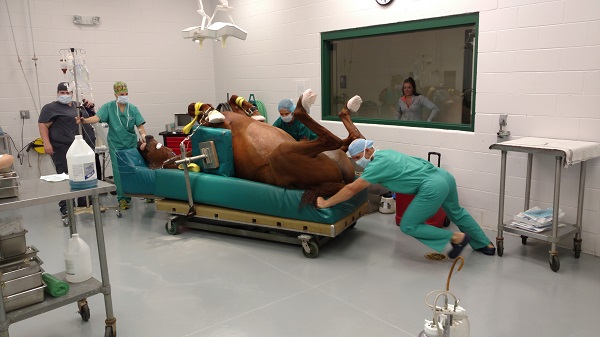Many of you know that in a recent ploy to get more attention, Dr. Lacher’s horse, Ernie, decided he’d like to have colic surgery. I interviewed Dr. Lacher to get all the details about her fun evening with Ernie. Read on for this fascinating interview with one of my favorite humans!
Tony: Let’s start at the beginning. When did you find out Ernie was colicking?
Dr. L: I had just returned to the Clinic around 5pm, and was working on paperwork when Lindsey, who helps me with the horses at home, called to say Ernie was definitely colicking. He had cast himself in the stall, but managed to get himself up, but went right back down. I finished what I had to get done, then rushed home to what I figured was a gas colic.
Tony: Why did you think it was a gas colic?
Dr. L: Because, as you have noticed from your time on the front porch at the Clinic, it’s really, really hot outside. That’s why you keep making us open the door so you can come back into the air conditioning. When it’s really hot outside, horses tend to make more gas in their large colon and cecum. These areas of the intestine are huge fermentation vats. More gas means a bit of pressure, and we all know gas can be uncomfortable.
Tony: Cats don’t “get gas.” We’re too classy for that, but I digress. When did you realize it was more than that?
Dr. L: The moment our third year veterinary student, Sydney, told me his heart rate was 56. You see, heart rate is a very good indicator of severity of colic. Simple gas colic horses will often have heart rates in the mid-30’s. They might be flailing on the ground and looking incredibly painful, but they still have a low heart rate. The rest of Ernie’s exam wasn’t that exciting. He didn’t have much for gut sounds, but that can happen in these situations. He had normal gum color and hydration, his respiratory rate was a little elevated at 24 breaths per minute, and his rectal exam was pretty boring. And then he blew through my sedation in 20 minutes.
Tony: Because he got painful again so quickly, you were concerned?
Dr. L: Yes. A typical mild colic might lay down a little bit after I tube them with water and electrolytes, but they don’t thrash around and act painful. Ernie got thrash-around painful. I gave him stronger sedation while I setup my ultrasound machine, and I re-palpated him. His rectal exam was still pretty normal but I had a pretty good idea why, and it wasn’t good news.
Tony: Wait, a normal rectal exam worried you? And what does an ultrasound show you? Ernie’s a gelding, so if I understand things correctly, he can’t be pregnant.
Dr. L: HaHa! No, Ernie is not pregnant. And yes, a normal rectal exam in this situation made me think epiploic foramen entrapment. This is a very specific type of colic which cribbers are prone to. The epiploic foramen is a hole formed where some bits of the stomach, pancreas, and liver come together. Small intestine works its way through that hole and then can’t get back out. The hole is pretty far forward in the abdomen, so I can’t palpate the problem. An ultrasound lets me look inside, though. The ultrasound showed some small intestine with thick walls, and that is definitely not normal.
Tony: All of this stuff together made you decide Ernie needed surgery?
Dr. L: Yep. Any horse who gets painful quickly after repeated doses of stronger and stronger sedation is a surgical concern. Also, anything small-intestine is a big deal, and the sooner you get those to surgery, the better they do. Finally, I would definitely do surgery on Ernie if he needed it, and since it looked like we were going to need to do surgery, the sooner I got him somewhere they could do surgery, the better. Even if we ended up going down to Equine Medical Center of Ocala (EMCO), and he didn’t need surgery, all we wasted was some time and a trip, but if he did need surgery, we had him where he needed to be as soon as possible. So that’s what we did.
Next week, hear all about how colic surgery works. It’s amazing, even to a cat. Until next week, may your horses not colic!
— Tony

